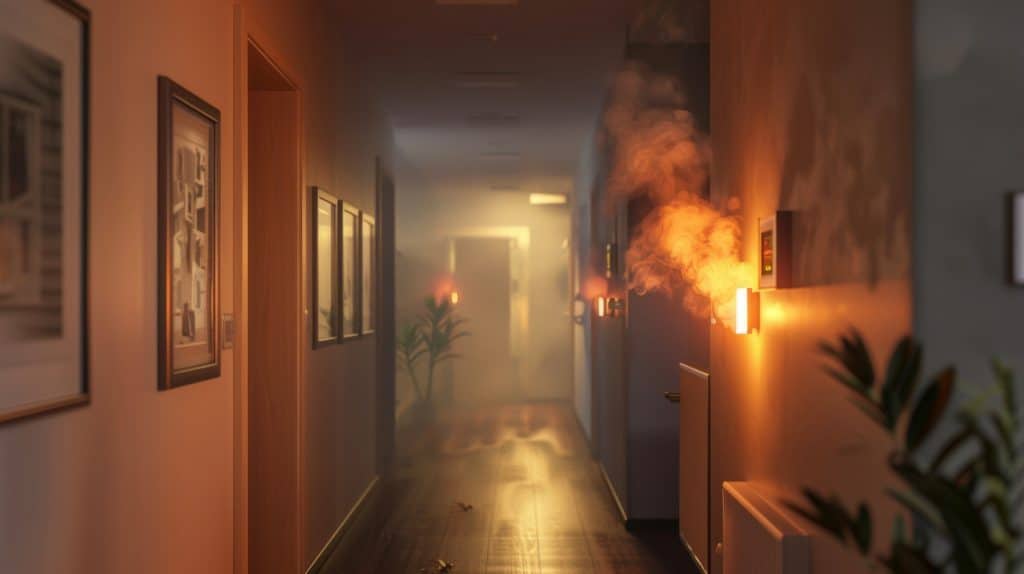Why small workarounds and quick fixes can quietly undermine your fire safety strategy
In the fast pace of daily operations, it’s not unusual to see a “temporary” workaround in a building. This could be a fire door wedged open “just for airflow”, a blocked riser cupboard “just until we sort storage”, or a cable hole filled with tissue “until maintenance gets to it.”
But the problem is, these quick fixes often stay that way. And over time, these minor oversights can add up to major fire risks.
In this blog, we’ll explore how temporary fire safety compromises become permanent hazards, why they matter, and how to spot and fix them before they put lives at risk.
The Problem with ‘Temporary’ Measures
Temporary fixes often happen because:
-
Someone needs a shortcut to get the job done
-
A longer-term solution hasn’t been signed off or budgeted
-
Staff don’t understand the fire safety implications
But buildings are complex, and fire safety relies on systems working as designed. When you bypass or alter those systems, even in small ways, the risk increases. Over time, a series of “minor” issues can make your fire strategy ineffective or non-compliant.
Common ‘Quick Fixes’ That Create Long-Term Risk
Here are some of the most common “temporary” solutions that often go uncorrected:
1. Wedged Open Fire Doors
Done for convenience, airflow, or to move stock. But a wedged-open fire door will:
-
Fail to contain fire and smoke
-
Break the building’s fire compartmentation
-
Invalidate your fire risk assessment
Solution: Install a certified hold-open device linked to the fire alarm system.
2. Blocked Escape Routes
Stock, chairs, bins, or deliveries stored “just for now” in front of fire exits, corridors, or stairwells can:
-
Delay evacuation
-
Cause panic in an emergency
-
Breach legal requirements
Solution: Establish clear zones around escape routes and enforce regular checks.
3. Damaged or Incomplete Fire Stopping
A contractor runs a new cable and leaves a hole around the conduit, filled with foam or fabric. Over time:
-
Smoke and fire can travel between compartments
-
Ceiling voids or risers become weak points
-
Your passive fire protection fails
Solution: Use proper fire-rated sealing systems and inspect work after contractors leave.
4. Missing or Outdated Signage
Temporary signage or handwritten labels get used “until the proper one is printed”… but never are.
Solution: Use standard-compliant fire safety signage (BS ISO 7010) and keep spares on hand.
5. Non-Functional Fire Doors
Fire doors with broken closers, misaligned latches, or missing intumescent seals often go unrepaired.
They may look shut, but if they don’t latch properly, they won’t work in a fire.
Solution: Add monthly fire door checks to your maintenance schedule and log all findings.
6. Disconnected Detectors or Alarm Devices
Alarms that are silenced due to nuisance activations (e.g. near kitchens or showers), or detectors taped over during building work, then forgotten.
Solution: Relocate problem devices rather than disabling them. Recommission systems after any work.
The Legal View: No Allowance for ‘Temporary’
Under the Regulatory Reform (Fire Safety) Order 2005, the Responsible Person must ensure that:
-
All fire safety systems are maintained in efficient working order
-
Fire doors, detectors, alarms, and compartmentation are not tampered with
-
Escape routes are kept clear at all times
There’s no exemption in the legislation for “temporary” measures. If an incident occurs and these quick fixes contributed to injury or loss, the consequences could include:
-
Fines and enforcement notices
-
Prosecution
-
Invalidation of insurance
How to Stop Temporary Measures Becoming Permanent
Build a Culture of Accountability
Make it clear that everyone, from caretakers to contractors, has a role in fire safety. If something isn’t right, it should be logged and corrected, not ignored.
Include It in Fire Walkthroughs
Train your fire wardens or facilities team to look for tell-tale signs of quick fixes during monthly checks:
-
Wedges or improvised door holders
-
Gaps in fire stopping
-
Storage in risers or corridors
-
Covered or disabled alarms
Prioritise Repairs and Budget for Compliance
Quick fixes often arise because the “real” fix seems too expensive or slow. Build fire safety works into your annual maintenance and budget cycles, and prioritise repairs that affect compliance.
Final Thoughts
Fire doesn’t wait for your building to be perfect; it strikes when least expected. And when it does, those little “temporary” workarounds can become the very reasons people don’t make it out.
If you’re the Responsible Person, caretaker, or facilities lead, now is the time to walk your building and ask:
What have we been putting off? What have we ‘fixed’ without fixing properly? Would this pass an inspection or fail in a fire?


